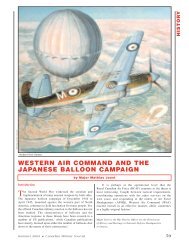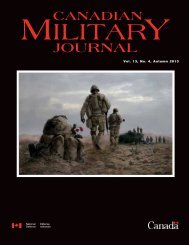MILITARY
JOURNAL CA - Revue militaire canadienne
JOURNAL CA - Revue militaire canadienne
- No tags were found...
You also want an ePaper? Increase the reach of your titles
YUMPU automatically turns print PDFs into web optimized ePapers that Google loves.
armed conflict was perhaps<br />
neither the best nor the only<br />
solution to the pressing issues<br />
facing Britain’s empire in the<br />
late-1800s. In the main, today’s<br />
problems are little different<br />
than those faced by Gordon,<br />
Butler, and their contemporaries.<br />
The confluence of past<br />
and present suggests that<br />
today’s world needs more<br />
Gordons – men and women<br />
who can think critically and<br />
appreciate problems from different<br />
perspectives. The NSP<br />
seeks to do just this by taking<br />
promising officers and strengthening<br />
these qualities within<br />
them. In so doing, this vital<br />
Canadian programme offers an<br />
educational environment of<br />
which both Gordon and Butler<br />
would likely be proud.<br />
NOTES<br />
1. The ‘Axis of Evil’ was first mentioned by<br />
President George W. Bush in his 2002 State of the<br />
Union address. See George W. Bush, “The<br />
President’s State of the Union Address,” 29<br />
January 2002; http://georgewbush-whitehouse.<br />
archives.gov/news/releases/2002/01/<br />
print/20020129-11.html, accessed 4 June 2012.<br />
The background of the term ‘Arc of Instability’ is<br />
somewhat more nebulous, with references to the<br />
term found as far back as the 1970s. Australia<br />
began using the term in the late-1990s in reference<br />
to areas of the Pacific, and it increasingly<br />
entered the US military planning lexicon in a<br />
broader geographical context following the 11<br />
September 2001 attacks.<br />
2. Department of National Defence, Canada First<br />
Defence Strategy (Ottawa: DND Canada, 2008),<br />
p. 6.<br />
3. Privy Council Office, Securing an Open Society:<br />
Canada’s National Security Policy (Ottawa: PCO<br />
Canada, 2004), p. vii.<br />
4. Ibid., p. 3.<br />
5. George F. Kennan, “Comments on the General<br />
Trend of U.S. Foreign Policy,” in George F.<br />
Kennan Papers (Box 23), (draft paper, Princeton<br />
University, 20 August 1948), quoted in John<br />
Lewis Gaddis, Strategies of Containment: A<br />
Critical Appraisal of American National Security<br />
Policy During the Cold War, 2 nd Ed. (New York:<br />
Oxford University Press, 2005), p. 26.<br />
6. Canadian Forces College, Joint Command and<br />
Staff Programme Syllabus: JCSP Residential and<br />
JCSP Distance Learning (Toronto: Canadian<br />
Forces College, 2011), 1-1/9.<br />
7. Earlier versions of these programs were the<br />
Advanced Military Studies Course and the<br />
National Security Studies Course. The change in<br />
title reflected a change in CFC nomenclature and<br />
did not significantly affect course curriculum,<br />
though the focus drifted more towards the strategic<br />
in the former. For ease, AMSP and NSSP<br />
Administration Building, Canadian Forces College.<br />
will be used in this document for standardization.<br />
8. Canadian Forces College, Advanced Military<br />
Studies Programme 10 Syllabus (Toronto:<br />
Canadian Forces College, 2007), para 201.<br />
9. Canadian Forces College, National Security<br />
Studies Programme 10 Syllabus (Toronto:<br />
Canadian Forces College, 2007), para 201.<br />
10. A review of CFC’s nominal rolls showed that only<br />
16 of 167 total students were not in the military;<br />
this equates to just under ten percent of the student<br />
population.<br />
11. Canadian Forces College, National Security<br />
Programme 1 Syllabus (Toronto: Canadian Forces<br />
College, 2008), 1-1/2.<br />
12. Chief of Military Personnel, CANFORGEN<br />
064/08 New National Security Programme (NSP)<br />
(Ottawa: DND Canada, 3 Apr 2008), para 3.<br />
13. Ibid., para 4.<br />
14. Ibid., para 2.<br />
15. Department of National Defence, B-GJ-005-500/<br />
FP-000 Canadian Forces Joint Publication 5.0<br />
(CFJP 5.0): The Canadian Forces Operational<br />
Planning Process (OPP), Change 2 (Ottawa:<br />
DND Canada, April 2008), paras 106.1-2.<br />
Strategic and operational refer in this case to two<br />
levels of war commonly discussed in PME.<br />
Contemporary CF doctrine defines strategy as<br />
“the concept that links available national resources<br />
to government ends – over time and as circumstances<br />
change. For the Department [of<br />
National Defence] and the Forces, strategy is<br />
about how to use our resources to best support the<br />
government’s aims” (106.1). The operational<br />
level, on the other hand, focuses on the “joint<br />
employment of land, maritime and aerospace<br />
forces employed in sequential and simultaneous<br />
engagements that are linked by design in a campaign<br />
plan” in an effort to meet strategic ends<br />
(106.2).<br />
16. For a list of fully equivalent schools, see Canadian<br />
Defence Academy, Canadian Defence Academy<br />
(CDA) Directive 02/12 Officer Developmental<br />
Period 4 (ODP4) Equivalency (Kingston:<br />
Canadian Defence Academy, 23 April 2012),<br />
A-1/1. Partial equivalency from a variety of programmes<br />
is also available as laid out in the subject<br />
document.<br />
17. Canadian Forces College, National Security<br />
Programme 4 Syllabus (Toronto: Canadian<br />
Forces College, 2011), 1-1/9. The aims for NSP 3<br />
and 4 are identical.<br />
18. Ibid., 1-1/9 through 1-4/9.<br />
19. Colonel Sir William Francis Butler, Charles<br />
George Gordon (London: MacMillan and Co.,<br />
1889), p. 85. This quote (or one like it) is often<br />
attributed to Thucydides, but this author could<br />
find no mention of it in any of the current or historical<br />
editions of the famous Greek’s History of<br />
the Peloponnesian War – his only known piece.<br />
The quote in this article can be attributed to<br />
Colonel Sir William Francis Butler, who wrote an<br />
important biography of Major-General Charles<br />
George Gordon, the British officer who famously<br />
met his end at Khartoum. In the passage preceding<br />
the above quote, Butler wrote:<br />
Gordon understood the fact that nations as<br />
well as individuals have pulses, that the<br />
leader who would lead to any definite end<br />
must know how to count these pulsations,<br />
and, in addition to his skill as a sword-cutter,<br />
must be able to do a good deal of the<br />
binding up of wounds, even though he had<br />
himself caused them. To say this is, of<br />
course, only to say that Gordon was great,<br />
in a sense greater than any merit of action<br />
in arms could aspire to.<br />
Gordon seemed to have understood that while war<br />
involves breaking, it also involves building.<br />
Likely, he would have been a keen advocate of the<br />
National Security Programme.<br />
DND photo by Sergeant Charles Barber, CFC<br />
<strong>MILITARY</strong> EDUCATION AND TRAINING<br />
Vol. 12, No. 4, Autumn 2012 • Canadian Military Journal 25





